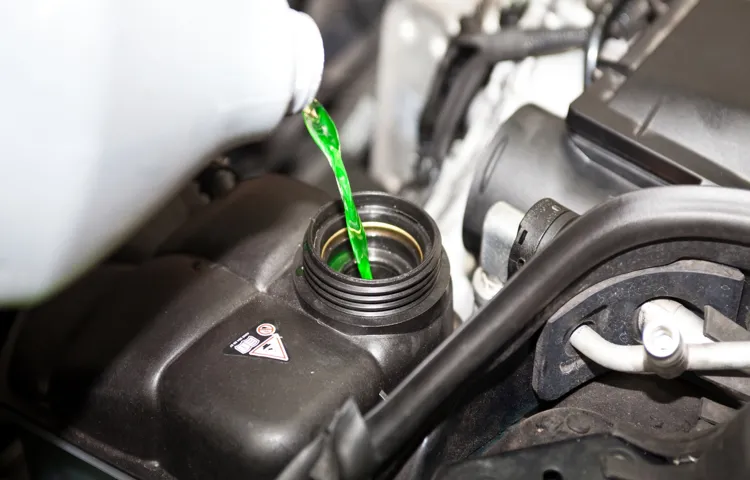Have you ever wondered what a coolant flush does for your car? Well, as the name suggests, it flushes out all of the old coolant and replaces it with new, fresh coolant. But why is this necessary? Coolant, also known as antifreeze, is responsible for regulating the temperature of your engine. Over time, however, it can become contaminated with rust, dirt, and other debris.
This can cause your engine to overheat, which can lead to expensive damage. In this blog post, we’ll take a closer look at what a coolant flush does and why it’s so important for the health of your car. So buckle up and let’s dive in!
Table of Contents
Introduction
What does a coolant flush do? A coolant flush is a maintenance procedure that involves draining the old coolant from your vehicle’s cooling system, and replacing it with fresh coolant. This helps to remove any contaminants and debris that can accumulate over time, as well as replenishing the corrosion inhibitors that protect your engine’s metal components from rust and corrosion. Additionally, a coolant flush can help improve the overall performance of your vehicle, as it helps to regulate the temperature of your engine, preventing it from overheating.
Regular coolant flushes can also help prolong the life of your vehicle, by reducing the risk of costly repairs caused by engine damage and failure. So, if you want to keep your car running smoothly for years to come, be sure to schedule a coolant flush every 30,000 to 50,000 miles, or according to your vehicle manufacturer’s recommendations.
Explanation of Coolant Flush
Coolant flush is one of the essential steps that every car owner should consider during routine maintenance of their vehicle. Over time, the coolant in your car can become contaminated with debris, grime, and rust. This can lead to corrosion of the engine and other costly repairs.
If you notice that your car’s engine temperature is increasing, or it is emitting steam, it is a sign of a coolant problem. A coolant flush is a process of draining the old coolant from the radiator and replacing it with a new one. It is recommended to get this done every 50,000 miles or as per the manufacturer’s recommendations.
A coolant flush not only keeps the engine cool but also improves fuel efficiency, protects the engine from corrosion, and prolongs the life of your car. So, if you notice any sign of coolant problems, it is better to get your car booked for a coolant flush.

Benefits of Coolant Flush
If you’re wondering what a coolant flush does, it’s a process of completely flushing out your engine’s old coolant and replacing it with fresh coolant. But why is this important for your vehicle? Firstly, coolant flushes help to remove rust and other debris that can accumulate in your engine’s cooling system and cause blockages. When these blockages occur, it can reduce the efficiency of your engine and cause overheating.
Secondly, a coolant flush can help to prevent corrosion from eating away at your engine’s metal surfaces, prolonging the life of your engine. Lastly, fresh coolant helps to lubricate the water pump, making it run smoother and last longer. Overall, a coolant flush is an important maintenance task that can help to prevent significant damage to your engine and keep it running smoothly.
Prevents Corrosion
When it comes to maintaining your vehicle, a coolant flush is often overlooked. However, it can provide numerous benefits in the long run. One of the most important perks of a coolant flush is its ability to prevent corrosion.
Over time, the coolant in your car’s system can become contaminated with rust and debris. This can cause corrosion, which can lead to leaks and other serious issues. A coolant flush replaces the old fluid with fresh, clean coolant that contains special additives that prevent corrosion.
This helps to extend the life of your engine and save you money on costly repairs down the road. In addition, a coolant flush can help to regulate the temperature of your engine, prevent overheating, and improve fuel efficiency. So if you want to keep your car running smoothly, consider getting a coolant flush today.
Maintains Optimal Engine Temperature
As a responsible car owner, there are some essential maintenance services that you should never overlook, like a coolant flush. Coolant or antifreeze is a vital fluid that prevents your car’s engine from overheating. Over time, the coolant can experience a build-up of sediment, rust, or other contaminants, which can cause your engine to malfunction.
That’s why a coolant flush is essential. Not only does it help to maintain optimal engine temperature, but it also provides several other benefits. A coolant flush ensures that there’s a sufficient amount of coolant in your engine, which helps to prevent corrosion and rust.
Additionally, it assists in lubricating the moving parts of your engine, which can keep it running smoothly. A coolant flush can also help to prevent leaks in the system, which can lead to significant repair costs. So, if you want to keep your engine running at its best, be sure to schedule a coolant flush service regularly.
It’s an investment that will keep your engine healthy for years to come!
Prevents Rust and Scale Buildup
A coolant flush is a vital maintenance procedure for your vehicle that offers a range of benefits, including preventing rust and scale buildup. Over time, coolant can become contaminated with rust, scale, and other debris that can accumulate in your engine’s cooling system. This can lead to blockages, poor heat transfer, and increased wear and tear on your engine.
By flushing your coolant system, you effectively remove these harmful contaminants and replace them with fresh, clean coolant. This helps to prevent rust and scale buildup, which can cause corrosion and damage to your engine’s metal components. So, if you want to keep your car running smoothly and avoid costly repairs down the road, be sure to schedule a coolant flush at least every two years or as recommended in your vehicle’s owner’s manual.
This simple maintenance step can save you time, money, and headaches in the long run, and ensure optimal engine performance.
When to Get a Coolant Flush
“What does a coolant flush do?” Well, a coolant flush is a process that involves removing all the old coolant from a vehicle’s radiator and replacing it with fresh coolant. This is important because over time, coolant can become dirty and contaminated with rust, minerals, and other debris. If you don’t get a coolant flush when you need one, these impurities can get lodged in your vehicle’s radiator and head gasket, which can lead to overheating and expensive engine damage.
So when should you get a coolant flush? Typically, you should get one every 30,000 to 50,000 miles, but check your vehicle’s owner’s manual for the manufacturer’s recommendations. If you notice any strange smells or leaks, or if your engine is running hotter than usual, it’s time to take your vehicle in for a coolant flush. By keeping your coolant clean and fresh, you’ll prolong the life of your engine and prevent costly repairs down the line.
Mileage-Based Recommendations
When it comes to maintaining your car, it’s important to know when to get a coolant flush. A coolant flush is essentially when the old coolant is drained out of your car and replaced with fresh fluid. So, when should you get one? Generally, manufacturers recommend getting a coolant flush every 50,000 to 100,000 miles.
This can vary depending on the make and model of your car, so it’s important to consult your owner’s manual or talk to a mechanic for specific recommendations. But, why is it important to get a coolant flush? Over time, coolant can break down and become contaminated, which can cause problems with your engine. Getting a coolant flush can help prevent overheating, corrosion, and damage to your engine.
Plus, it’s a relatively simple and affordable maintenance task that can pay dividends in the long run.
Time-Based Recommendations
When it comes to getting a coolant flush, many drivers might wonder when is the best time to schedule this important maintenance task. Generally, most automakers and mechanics recommend having a coolant flush performed every 30,000 to 50,000 miles or every three to five years, depending on your vehicle and driving habits. However, it’s important to keep an eye on your car’s owner manual for the manufacturer’s recommended maintenance schedule.
Factors like extreme weather conditions, stop-and-go traffic, or towing heavy loads can also put added strain on your engine, leading to quicker wear and tear. Keeping up with routine coolant flushes can help ensure your engine stays properly cooled and can prevent costly repairs down the road. So don’t skip out on this essential maintenance task, make sure to schedule a coolant flush appointment at the recommended interval to keep your engine running smoothly.
Conclusion
In summary, a coolant flush is like giving your car’s engine a refreshing spa treatment. It helps remove any harmful buildup and contaminants, ensuring that your engine stays running smoothly and efficiently. Think of it as a preventative measure to keep your car from overheating and leaving you stranded on the side of the road.
So, don’t let your neglected coolant become the new hot tub for gunk and debris. Treat your car to a coolant flush and keep the engine cool, calm, and collected!”
FAQs
What is a coolant flush?
A coolant flush is a maintenance procedure that involves draining, cleaning, and refilling the cooling system of a vehicle with fresh coolant.
How often should I have a coolant flush done?
The recommended interval for a coolant flush varies depending on the make and model of your vehicle, but it is generally recommended to have it done every 30,000 to 50,000 miles.
What are the benefits of a coolant flush?
A coolant flush helps to remove contaminants and debris from the cooling system, prevents corrosion, and extends the lifespan of your engine by keeping it at the optimal temperature.
Can I perform a coolant flush myself?
While it is possible to perform a coolant flush yourself, it is recommended to have it done by a professional mechanic to ensure that the procedure is done correctly.
How much does a coolant flush cost?
The cost of a coolant flush can vary depending on the make and model of your vehicle, but it typically ranges from $100 to $200.
What are the signs that I need a coolant flush?
Signs that you may need a coolant flush include overheating, a sweet smell from the engine, reduced fuel efficiency, and discolored or dirty coolant.
What type of coolant should I use in my vehicle?
The type of coolant recommended for your vehicle depends on the make and model, but it is important to use the coolant specified by the manufacturer to ensure that it is compatible with your engine and cooling system.


